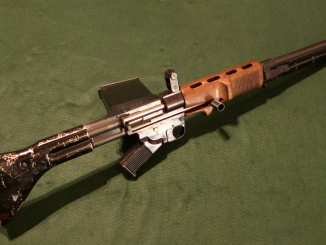When the German attack into Russia stagnated in late 1942, some areas of the front returned to a trench-and-sniper sort of warfare that was reminiscent of World War One. The German military actually went so far as to design and issue a periscopic tech rifle mount, the “deckungszielgerät” (DZG). Stereotypically German in design, it was adjustable to fit a variety of different rifles. The original design intent was for the Gewehr 41(M) and 41(W), but the devices were quickly modified to also fit captured SVT-40 rifles, and the K98k could also be used if necessary (although unlike the WW1 trench rifle mounts, these had no mechanism for cycling a bolt action).
It is unclear how many DZGs were actually made, but certainly not many. This example has been heavily restored, but none of the known surviving ones have serial numbers of manufacturer codes (the “DZG” stamped on the side is its designation, not a manufacturer). For more information, see Michael Heidler’s article in Small Arms Review:
http://www.smallarmsreview.com/display.article.cfm?idarticles=315



This rifle is a perfect meme for people who disagree with the bore axis / straight-line stock principle (AKA the laws of physics).
*setup, not rifle
Regarding this issue interesting photo was unearthed
https://www.kalashnikov.ru/zagadochnyj-priklad-dlya-ak/
sadly its history is not known
I assume you’re joking . . .
Put that on a shotgun and that’d be my preferred home defense set up: “A man’s home is his castle! Especially when its a bunker!” Or something.
So you need hail of lead without exposing yourself? Look no further, just grab this bent SGM https://www.pinterest.ru/pin/686376799441585198/
https://www.popularmechanics.com/military/weapons/a21800/forgotten-weapons-wwii-curve-a-bullet/
Apparently the krummlauf was hell on barrel life… Still, if 7.92x33mm kurzpatrone, and .45 acp M3 grease gun, why not other calibers, eh?
At the military museum in Vienna/Wien, Austria there’s a WWI version with a periscope and a mechanism for operating and shooting the “ruck-zuruck” straight-pull M.95 Mannlicher rifle…
I have seen the same model of chain attached to an old toilet flushing system. Another kind of triger I suppose.
Maybe the designer was making a statement.
As old adage goes If it is stupid but it works, it isn’t stupid.
It does appear in Soviet book Strelkovove orugie 1947. Following data are provided:
weight 5,6 kg
length 480 mm
height 290 mm
width 130 mm
It report it is supposed to be used with Mauser 1898 rifle, self-loading rifle pattern 1941 and other rifles.
The literal translation of “deckungszielgerät” is “cover line device”, though I’m not sure whether “cover line” refers to the trench line, or whether “line” is referring to the mechanism for pulling the trigger.
Oddly enough, in Russian “Deckungszielgerät” translates as “mortar target”
It would be better translated as “covered aiming device” that is, aiming from behind cover.
Name consist of three parts
Deckung
ziel
Gerät
first means hideout, second is derived from zielen i.e. aiming and last is device so in English language it should probably be Deviceforaimingfromhideout
Not really, since closed compound words are not very common in the English language and they usually have only two parts instead of the multiple parts common in German. So, an open compound would be more appropriate: for example “hideout aiming device”. Although “hideout” is probably not the best translation of Deckung.
Ok, what is interesting is that they did not recycled Spiegelkolben name as used during previous war.
Typical German cowardliness. Stand up like a man rather than cowering in a trench !
Wonder if former Great War infantryman Adolf had anything to do with it
In a generation, I guarantee you that the level of battlefield lethality will be such that the average infantryman will likely require the 21st Century version of this–An individual Remote Weapons Station, if you will. Certainly, the crew-served weapons tripod mounts will be replaced by such things, probably also on a “Big Dog” sort of mobility chassis.
21st Century trench rifle? Uh, yeah, it certainly sounds good for someone doing sentry duty. Stick something else on the platoon’s machine gun (hopefully the MG3) to make a temporary Remote Weapon Station? Sounds MUCH more authoritative to me. I could be wrong.
I remember a cover illustration from one of the early “science” magazines (Electrical Experimenter I think) showing a trench line full of gun turrets with machine guns, all remote-controlled.
Considering that the turrets were armored cupolas and the remote control was by wire (thus avoiding RF jamming problems), oddly it would seem to still be an entirely viable option for a static front today.
Anyone who thinks static fronts ended in Flanders in 1918 never looked closely at the Iran-Iraq War of 1980-90. It looked very much like Third Ypres aka Passchendaele for the last half of the conflict.
As you have said, the German doctrine of “send bullets, not men” is still probably the best method overall.
cheers
eon
“Anyone who thinks static fronts ended in Flanders in 1918(…)”
But was not whole point of Germany military planning in 1930s to avoid stalemate, as this would mean it would then be industrial prowess vs industrial prowess?
Yes, that was the plan.
I think there are fairly good reasons to consider the Iran-Iraq War an anomaly caused by the tactical and operational capabilities and lack thereof of the participants. That does not mean field fortifications are obsolete, quite the opposite in fact, but all systems should be designed to be mobile instead of static. Therefore remote turrets controlled by wire only would not be a very good idea. At the very least they should have both wire and radio control as options.
“How’s the trigger?”
“Breaks like a frozen dog leash.”
Well this is a new one: Preparing for the last war during the already ongoing next war. But nonetheless it is a nifty contraption.